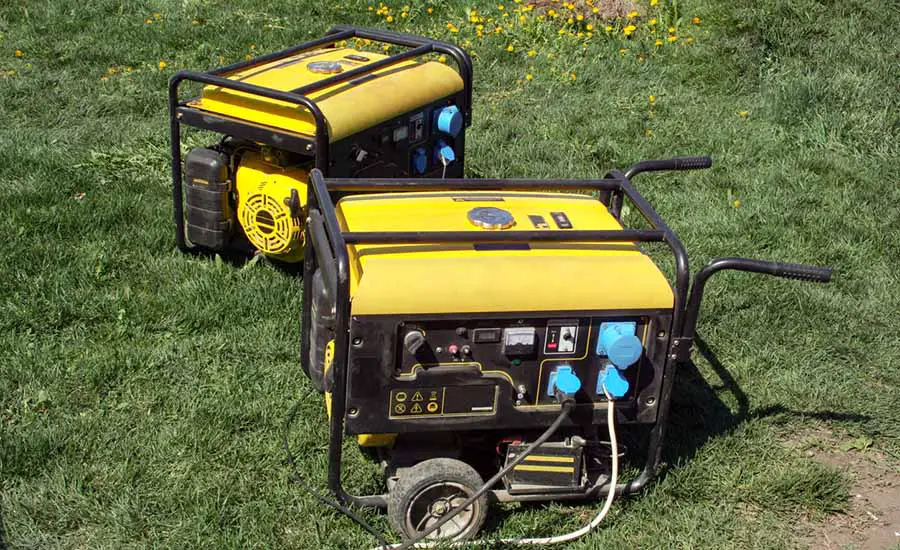
Noise pollution is not just irritating. It can be harmful to mental and physical health as well as the environment. Before buying a generator, you need to think about where you will locate it on your property. Your generator choice may be influenced by how much noise it makes, especially if you have neighbors nearby.
Noise levels range between 50 dBA and 80 dBA depending on generator type, size, and manufacturer. Gas generators come in 2 varieties, inverters and standard, with inverters being quieter than standard generators. Newer diesel generators are as quiet as standard gas ones, except when they are idling.
To fully appreciate how noise levels are measured, you need to understand what decibels are and how a generator makes noise. The distance at which you measure the level of sound from its source is also a factor.
Diesel Vs. Gas Generator Noise Levels
When compared to inverter generators that run on gasoline, diesel generators are much noisier. However, when compared to standard gasoline generators, they operate at roughly the same noise level.
You usually measure generator noise levels at seven meters away (23 feet) from the source. This is an industry-standard. Obviously, the closer you get to the generator, the louder the sound becomes. Portable gasoline inverter generators typically range between 50 dBA and 60 dBA and are now designed with noise-reducing features.
Noise ratings usually increase with the power and size of the generator. A small diesel generator with 50 kW output might generate the same noise as city traffic, about 85 decibels. By contrast, 1,500 kW models may emit about 105 decibels, comparable to the sound of a jet flying about 1,000 feet overhead.
Every generator operates at a higher or lower noise level depending on the load and output. For every appliance you plug into the generator, it will make more noise. Therefore it is recommended that users wanting a backup generator for the home or camping should buy a generator with a larger capacity than they require to reduce the noise level.
At a quarter load, the 53 decibels of sound produced by some gas inverter generators are around the noise level of quiet conversation at home. One 4,000-watt gas generator with a 2.9-gallon fuel tank is about as loud as turning on a garbage disposal (64 dBA) when tested at a quarter load level. The load level placed on a generator can significantly influence the noise it makes.
Manufacturers measure generator noise levels with the generator standing in the open clear of buildings. If generators are in an enclosed area, the sound bounces off hard surfaces and can be much louder. The typical standard for canopied diesel generators is approximately 80dBA at one meter in free field conditions.
You usually enclose large standby diesel generators in canopies made of sound-absorbent material to reduce noise levels. Air intake and outlet exhaust openings allow noise to escape, so they usually have sound-absorbent baffles.
Understanding Generator Noise Levels In Decibels

Sound is produced by vibrations and reaches the listener’s ear in the form of air pressure waves. Technically it is a variation in pressure in the region adjacent to the ear. When the sound level becomes uncomfortable or annoying, the air pressure variations near the ear have reached an amplitude that is too high.
The decibel, typically abbreviated dBA, is the unit used to measure the intensity of a sound. Near silence registers at zero decibels. A ten-decibel increase means the sound is ten times louder. Thus decibel loudness scale is not linear but logarithmic. The range of human hearing is from 0 dBA to over 140dBA, but at 150 dBA, eardrums can burst.
A sound at 70 decibels is ten times louder than at 60 decibels, which is considered relatively quiet. A noise level of 50 decibels is really quiet. Office or restaurant conversation measures around 65 decibels, and quiet conversations at home are between 45 and 50.
A generator that runs at 74 decibels is relatively loud and may annoy the neighbors. A generator is considered quiet if it runs at 60 decibels or less while running a quarter load. A person’s tolerance for noise diminishes the longer it lasts, so switching off a generator is considerate when you aren’t using it.
A vacuum cleaner comes in at around 70 decibels and a jackhammer at about 100 decibels. A petrol lawnmower is also around 100 decibels. At 110 decibels, many people experience pain, and the noise can cause long-term hearing damage. This is often the noise level in front row seats at a rock concert.
According to the National Institute of Occupational Safety (NIOSH), the safe exposure limit for noise at 115 decibels is only 28 seconds. The Environmental Protection Agency says that noise exposure louder than 70 dB over 24 hours will damage hearing.
Sources Where Generators Make Noise
Generator noise comes from different sources. Engine noise is caused mainly by mechanical and combustion forces within the engine and, at a distance of one meter, ranges from 100 dBA to 121 dBA, depending on engine size.
Noise can come from cooling fans due to air moving at high speed across the engine. Induction noise is caused by alternations in the electrical current of the alternator.
Exhausts also contribute to noise, especially if there is no silencer. When it is running, a generator vibrates, and this generates structural or mechanical noise. Over the years, manufacturers of diesel generators and gasoline generators have done a lot to reduce the noise.
Old diesel generators are notoriously loud, but things have changed a lot since then. The new diesel engines are a lot quieter than previous generations. Diesel generators can vary enormously in size and are used in industrial applications and even the electric grid network. This article discusses only backup and standby generators.
Regulating Noise Pollution
In North America, maximum permitted noise levels range from 45 dBA to 72 dBA, depending on location and zoning. Some states have recently started to specify property line noise restrictions to reduce the low-frequency noise that reaches community neighborhoods.
Acceptable noise levels may also vary between day and night, particularly in residential areas. You are generally permitted higher noise levels in industrial areas than those where people live.
Cities and counties usually measure the level of noise at property lines and may have their own rules about acceptable noise levels.
Limiting Generator Noise
You can take a few different steps to reduce the noise levels of your generator.
- Move the generator further away if possible
- Place anti-vibration mounts or rubber underneath the generator
- Add flexable joints between the generator and conneciting systems
- Build a wall around the generator to dampen noise
If you are worried that your generator will bother the neighbors, move the generator as far away from your property line as possible. The further away the generator, the greater the distance the sound energy spreads, and the lower the acoustic intensity.
Positioning anti-vibration mounts underneath the generator isolates vibrations and reduces noise transmission. There are many different options – rubber mounts, spring mounts, and dampers. Placing the generator on rubber padding is also useful.
Fitting flexible joints between the generator and connecting systems will also reduce noise transmission. Building a wall around a generator is one of the quickest ways to reduce noise output significantly. This can be as simple as stacking cinder blocks around the generator.
Built-In Noise Reduction In Diesel Generators
Recently, diesel generator manufacturers have produced quieter models through improvements in internal combustion controls, fuel injection, and internal combustion technology. Newer designs focus on smooth-running engines and vibration reduction.
Some companies that make diesel generators also make enclosures to help dampen sound. The better ones reduce noise levels by as much as 40 decibels. This easily brings most generators well within noise control standards.
Bear in mind that using enclosures is risky because of fumes and exhaust. Companys that produce generators design purpose-made enclosures for diesel generators with safety in mind. No generator should be running inside a house where people are living. They all emit dangerous carbon dioxide fumes that can suffocate humans and pets.
Conclusions
Most of the time, modern diesel generators are no louder than standard gasoline-powered generators. They may even be slightly quieter in some instances because gas-powered generators run hotter and need a higher number of revs per minute to generate the same level of energy.
Inverter generators, which use gasoline, are far quieter, although they are more expensive than standard gas generators. Diesel generators tend to cost more than standard gas generators. If noise levels are an essential consideration, an inverter generator is the best option.
